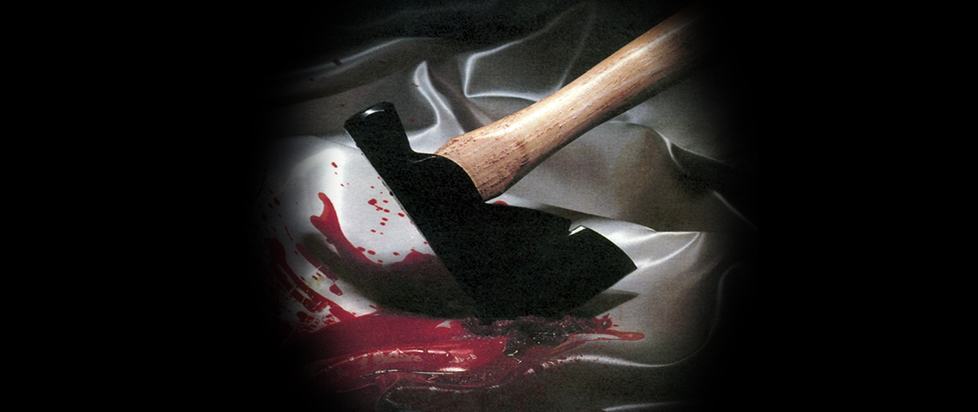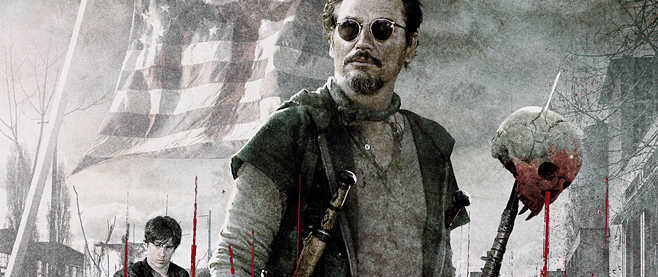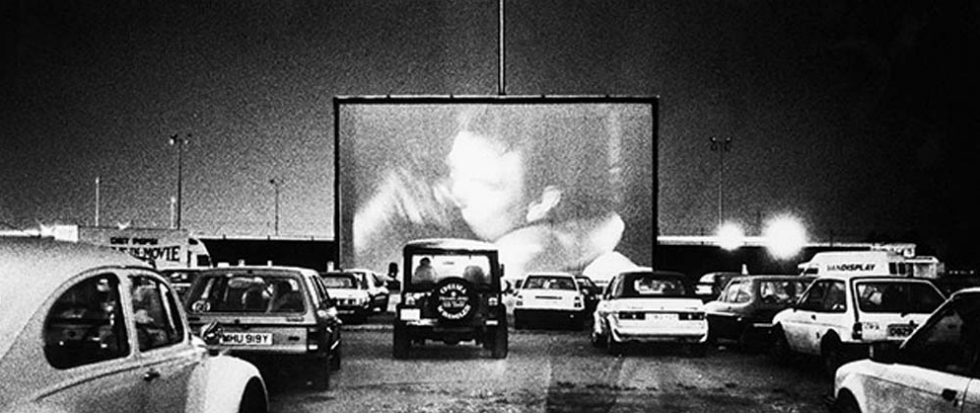
Now She’ll Be All Alone: The American Horror Project Volume 2
“We are all haunted by things other than the dead.” – Dream No Evil (1970)
I missed out on the first volume of Arrow Video’s American Horror Project. There’s no story here, I just wasn’t aware of it at the time it came out. So, when the opportunity to review the second volume came up, I jumped on it.
The first thing that attracted me to the American Horror Project set was not anything to do with the movies inside, which I had never so much as heard of; it was how great the set looks. Shallow confession: I am a sucker for good packaging. It’s one of the things that keeps me addicted to physical media in an increasingly digital age.
Arrow always delivers in the packaging department, and this set is no exception. The muddy artwork that is a sort of composite mosaic of scenes from each picture is rendered in such vibrant colors that it knocks that muddiness right out the window. It’s a striking aesthetic, to be sure.
Based just on the movies contained in this set, it also fits the series nicely. Nothing in here is ever quite as lurid as those covers may look, with the possible exception of The Child, but that was true of their original posters, too, which are available as alternative art on the other side of the sleeve.
Dream No Evil (1970)

Ever wonder what it would have been like if Tennessee Williams had been tapped to write an AIP shocker in his waning years? I give you Dream No Evil. Also known as Now I Lay Me Down to Die, this sunny gothic was helmed by John Hayes, whose other directorial credits include low-budget horror pictures like Garden of the Dead and Grave of the Vampire, but also titles like Jailbait Babysitter and Heterosexualis.
In the essay that accompanies the American Horror Project Blu-ray set from Arrow Video, Amanda Reyes points out that Dream No Evil probably played in “sleazy 42nd Street type venues or drive-ins,” where the audiences must have been very disappointed in what they saw. Indeed, even more contemporary reviews haven’t always been kind to this dreamy and glacially-paced film. The Video Vacuum, for example, calls Dream No Evil “just another tame ‘70s psychological horror flick.”
Tame it most certainly is, and psychological as well, but that “just another” implies that there were boundless horror movies this fundamentally disinterested in their horror premise being released in the ‘70s, which doesn’t seem to be borne out by at least my experience with the genre. That said, the basic elements of Dream No Evil all seem familiar enough:
A young girl grows up in an orphanage dreaming that one day her father will come and rescue her. It is here that the voiceover narration begins, giving Dream No Evil the feel of a contemporary fairy tale, telling us that her “innocent dream” will become “a bridge to horror.”
She is adopted into a “once-respectable” church which has been turned into a “carnival” by its new proprietor and her adopted brother Paul Jessie Bundy, played fantastically by Hayes regular Michael Pataki. There she grows up into a lovely redhead (Brooke Mills) who performs a high dive act as part of the traveling church’s faith healing demonstrations, falling into the metaphorical fires of hell in a skimpy, sequined outfit for the edification of audiences.
In her essay, Reyes argues that the film condemns this sort of charlatanry, but I was actually surprised at how sympathetically it was portrayed. I spent probably half the movie waiting for Pataki’s Reverend Jessie to turn into a villain, especially as the film sets up a love triangle – quadrangle, really – with Mills’ character engaged to her other adopted brother, who has abandoned the church to go to medical school and who is gradually falling for a fellow student and more modern woman.

That sounds like a lot – and it is – but really none of it is the film’s focus. You see, Mills’ character is still obsessed with finding her father, which she thinks she does when the traveling church stops at a town where he once lived.
There, she goes to a frightening flophouse where aged women of the night are dispatched by a polite yet slightly sinister pimp/undertaker to comfort silent old men – it both isn’t as weird as it sounds and is even weirder. The undertaker (played by character actor Marc Lawrence) says that he was a friend of her father’s, but that he died just the day before.
He takes her to his dilapidated brothel/funeral home – which is located in one of the strangest buildings I have ever seen in a film – so that she can view the body, and there her faith healing powers bring her father (played by Edmond O’Brien, the film’s biggest star) back to life in probably the movie’s most effective horror moment. Unfortunately, that voiceover narration comes barging back in here, informing you without a doubt that none of this is real and that Mills’ character has simply retreated into a world of fantasy.
To a modern viewer, that would probably have become clear soon enough anyway, but there’s no denying that the voiceover – apparently added in by meddling producers, to the surprise of no one – makes a mess of what is otherwise a strangely effective film, if not particularly effective at being horrific.
The horror elements come as Mills’ character commits murders – which she thinks are being committed by her father – in order to protect the fantasy that she has created. But the film seems far less interested in those killings than it does in her own fragile psyche; which is probably both why Amanda Reyes can call it “a very special film, indeed,” in her essay and why viewers who watched it in a DVD set called the “Psychotronica Collection,” where it is available from Amazon, may have been sorely disappointed.
Dark August (1976)

The most striking thing about Dark August is its regionalism. So legendary Swamp Thing artist Stephen R. Bissette implicitly argues in the essay that accompanies the Blu-ray, the lion’s share of which is devoted to discussions of this and other films that were shot in and around his native Vermont.
In this way, Dark August actually reminded me a bit of the original Friday the 13th, which was filmed in New Jersey, not Vermont, but which nonetheless manages to contain that same sense of regional filmmaking. As the Jersey countryside was in Friday the 13th, the Vermont hills are a character in Dark August, every bit as much as (and maybe more than) its human protagonists.
Dark August is no slasher film, though. Not even a Psycho-alike proto-slasher, as was Dream No Evil. Instead, it is a full-bore folk horror, every bit as much as its contemporaries across the pond, which eventually gave us the term, though it hadn’t been coined yet in 1976 and, indeed, wouldn’t be for decades. In fact, Dark August has essentially the same plot as the 1988 Lance Henriksen monster movie Pumpkinhead, albeit told the other way around and with a lot less monster.
“Flatlander” Sal Devito (J.J. Barry) is an outsider from the big city who has settled in rural Vermont for less than a year when he accidentally runs down a young girl. Her grandfather places a curse on him, and it is the working out of this curse that provides the film’s horror.

Though the curse invokes “Baal” and his “demon cohort,” the trappings of it are pure folk magic, which we see in a slow pan across resin, wax, spent matches and dried seed husks. All of this is just moments into the movie. In fact, when we meet our ostensible protagonist, the deed has already been done, and he has been acquitted of any wrongdoing. It isn’t until almost half-an-hour into the film that we actually see the accident in flashback.
Where Pumpkinhead placed its sympathy heavily with Henriksen’s bereaved father, in Dark August we are ostensibly supposed to root for Sal – and the film, at least, does a good job of humanizing him, even if, as Bissette points out, Sal still “embodies the worst of ‘flatlander’ misbehavior and belligerence.” Ultimately, it’s as much Sal’s machismo – what we would today identify as “toxic masculinity” – that undoes him as the old man’s curse.
Sal simply lacks the mental or emotional tools to deal with the guilt of his deed – let alone the curse that is that guilt’s concrete manifestation – and it lies with the “white magic” of women to provide his only conceivable means of salvation. (“There’s a very good woman who is going to help you through this.”)
Wrapped around Sal’s dissolution is a fascinatingly-wrought if extremely slow-moving regional folk horror that could have been one of the “elevated horror” films that we’re getting in the theaters these days, albeit less polished and with a lower budget.
And I haven’t even mentioned the amazing soundscape.
The Child (1977)

“What the hell did I just watch?” is a sentiment normally reserved for more gonzo movies than anything that The Child ever even strives for, but it’s appropriate enough here. One user on Letterboxd calls it “a paperback gothic cover come thrillingly alive,” which is also a good description.
Slow and dreamy is apparently the order of the day in this particular installment of the American Horror Project, and The Child is no exception – a picture at once stranger and more traditionally “horror” than either of the films that accompany it. The plot is certainly something straight out of a paperback gothic, with a governess who comes to a big, dark house in the woods to care for the strange and morbid little girl who spends most of her time in the nearby cemetery hanging out with her “friends.”
That’s not some kind of metaphor or a lonely little girl’s imagination, either. This cemetery is haunted by actual ghouls and/or walking corpses, a fact that is apparent before the credits even finish rolling, when we see the little girl handing one of them a kitten. While it takes a long time before the ghouls come bobbing into full sight, their presence is always felt around the edges of the frame, even as the entire atmosphere is eerie and oppressive enough to render them all-but unnecessary.
The woods in The Child remind me a lot of how vegetation sometimes appears menacing and claustrophobic in old paintings, while the cemetery is blown by a constant pall of the requisite fog. The wind constantly rattles the leaves and pushes the clouds through the sky overhead. The day-for-night shots add to the visual disquiet and the night shots are so dark and grainy that they take on the quality of found footage.
 Filmed mainly on “short ends,” the bits of film stock that are left over when another movie is done shooting, The Child is one of those films that has an uncanny effectiveness because of – rather than despite – the qualities that would otherwise make it not as good.
Filmed mainly on “short ends,” the bits of film stock that are left over when another movie is done shooting, The Child is one of those films that has an uncanny effectiveness because of – rather than despite – the qualities that would otherwise make it not as good.
Disorienting cinematography, head-scratching close-ups and hand-held shots, dubbed-in dialogue performed as if the characters are repeating memorized speeches in separate rooms, a soundtrack that is mostly a lot of heavy banging on the piano and discordant notes. (The music is credited to Muckandmire Music Company, which sounds about right.) Instead of reducing the power of the film, these things weave themselves into The Child’s oppressive atmosphere to give the whole proceeding an air that it would lose if the same stuff was shot “better.”
Does that mean The Child is good? I’m not here to decide that for you. What I’ll tell you is this: Zombie hands grab an old lady’s ankle from under the stairs, the young governess dances with a scarecrow and there’s a lengthy sequence set on Halloween that features a creepy rotating jack-o-lantern. By now, you’re either sold or you’re not, and nothing else I can say matters very much.
***
If “slow and dreamy” is antithetical to your enjoyment of horror movies, you will want to give this set a wide berth. If it is practically a requisite, then have I got a trio of movies for you! For everyone else, mileage will vary from one title to another and the price tag on this set means that it’s probably best reserved for die-hard fans of regional and cult horror cinema.
Even if I didn’t love any of the films contained in this set, though – and I might have loved The Child, I honestly couldn’t tell you – there’s no doubt that Arrow is doing the proverbial lord’s work by giving such loving, hi-def releases to these kinds of underseen films. While these movies will not be for everyone – or, indeed, probably for most – there’s someone out there who is waiting for a film just like each one of them, and they might never have gotten a chance to see them if it hadn’t been for releases like this.





